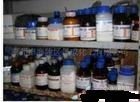Nitric acid* is used primarily in the preparation of inorganic sample types.++ It is a very useful component in the destruction of organics but cannot by itself completely decompose organic matrices.
*All reference to HNO3 will mean 69% 'concentrated' nitric acid unless specified otherwise.
++The conventional meaning of inorganic is intended along with the presence of low molecular weight water soluble organic cmpds. and organometallic cmpds. containing relatively small molecular weight organic components.
The following is a summary of some common inorganic dissolutions using nitric acid:
Dilute 10 - 15 % aqueous dilution - Alkaline earth oxides, lanthanide oxides, actinide oxides, Sc2O3, Y2O3, La2O3.
1:1 HNO3 + H2O - V2O5, Mn oxides, CuO, CdO, Hg oxides Tl oxides, Pb oxides, Bi oxides, Cu0, Zn0, Cd0, Hg0, Pb0.
Concentrated (69%) HNO3 - Mn0, Fe0 (hot), Co0, Ag0, Pd0 (hot), Se0, As0, Bi0, Re0.
1:3 HNO3 + HCl - Pt0, Au0, steel, Fe/Ni alloys, Cu alloys, Cr/Ni steel.
1:1:1 HNO3 + HF + H2O - The metal and oxides of Ti, Zr, Hf, Nb, W, Sn, Al, Si, Ge, Sb, Te, As, Se, Mo and numerous alloys and oxide mixtures containing one or more of these elements.
The only major group of elements not listed above are the alkaline earths, of which are all water soluble.

